 W
WJohann Reichsgraf von Aldringen was an Austrian soldier active before and during the Thirty Years' War. He was born in Luxembourg City in the Grand Duchy of Luxembourg, and after travelling as a nobleman's page in France, Italy and the Netherlands, he went to the University of Paris.
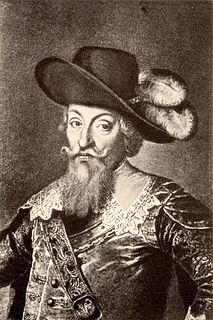 W
WJohann or Hans Georg von Arnim-Boitzenburg was a German general. At different times during the Thirty Years' War, he was a Field Marshal for the Holy Roman Empire and its opponent the Electorate of Saxony. He also pursued various diplomatic tasks.
 W
WMargrave Leopold Wilhelm of Baden-Baden was Field Marschal of the Holy Roman Empire of the German Nation.
 W
WBlaise Colomban Bender or Blaise Colomban, Baron Bender was an officer for over sixty years in the Imperial Army or Kaiserliche Armee, the force directly recruited by the Holy Roman Emperor without the need for permission from the Imperial Diet., whose archaic mode of recruitment in the many Circles of the Empire led to its losing its importance and the Imperial Army becoming the Empire's effective field force.) In his long career he fought in twenty-nine campaigns, twelve major battles and six sieges.
 W
WMarchese Alessandro dal Borro was a Tuscan nobleman and general. He became a Field Marshal of the Holy Roman Empire. He was well known for his obesity.
 W
WJohann Jakob von Bronckhorst, named Graf Anholt, was Count of Bronckhorst-Batenburg and Imperial fieldmarshal during the Thirty Years' War.
 W
WCharles Bonaventure de Longueval, Count of Bucquoy was a military commander who fought for the Spanish Netherlands during the Eighty Years' War and for the Holy Roman Empire during the Thirty Years' War.
 W
WCount Aeneas Sylvius de Caprara, also known as Enea Silvio or Äneas Sylvius von Caprara, was an Austrian Field Marshal during the Nine Years' War.
 W
WAntonio von Caraffa was a General Commissary (Generalkriegskommissär) of the Imperial-Habsburg Army—the highest rank in the Austrian military hierarchy at the time. He also held various other high-ranking offices, including military governor of Upper Hungary and later royal commissioner of Transylvania.
 W
WCharles II, Duke of Elbeuf, was a French nobleman, the son of Charles I, Duke of Elbeuf, by his wife, Marguerite de Chabot. He succeeded his father in the Elbeuf dukedom in 1605.
 W
WCharles de Lorraine, Prince de Commercy, was a French field marshal of the Holy Roman Empire and a military adivisor to Prince Eugene of Savoy. He acquired military prominence after leading imperial troops in the Great Turkish War, in the Nine Years' War, and the War of Spanish Succession.
 W
WCharles Theodore Otto, Prince of Salm, was Count of Salm-Salm since 1663 and Obersthofmeister at the Austrian Court.
 W
WChristian Ernst of Brandenburg-Bayreuth was a member of the House of Hohenzollern and Margrave of Brandenburg-Bayreuth.
 W
WCount Christian Louis of Waldeck was from 1645 Count of Waldeck-Wildungen and from 1692 Count of Waldeck and Pyrmont.
 W
WRudolf Hieronymus Eusebius von Colloredo-Waldsee, born 2 November 1585 in České Budějovice, Kingdom of Bohemia, was a Bohemian nobleman and the brother of Hieronymus von Colloredo-Waldsee. A member of the Colloredo family, he distinguished himself in the Thirty Years' War, especially at the Battles of Mantua and Lützen. Emperor Ferdinand III appointed him to the Imperial Privy Council and named him a Field Marshal. Although unable to prevent Prague Castle from falling to Sweden's Hans Christoff von Königsmarck, Colloredo-Waldsee's bold defense of Prague's old town halted the Swedish invasion of Bohemia on 26 July 1648 and saved the Habsburg's ancestral lands in Austria. After the war, he built the Schönborn Palace in Prague home to the United States Embassy to the Czech Republic. He died in Prague on 24 February 1657.
 W
WTorquato Conti (1591–1636) was an Italian military commander who served as a General-Field Marshal of the Holy Roman Empire during the Thirty Years' War. His barbarous treatment of defenceless villagers earned him the nickname, The Devil. He later became a nobleman and was made Duke of Guadagnolo and Gonfalonier of the Church by Pope Urban VIII.
 W
WRamboldo XIII, Count of Collalto was an Italian Imperial commander.
 W
WCharles Eugène de Croÿ was a German and Russian Field Marshal and nobleman from the French noble House of Croÿ.
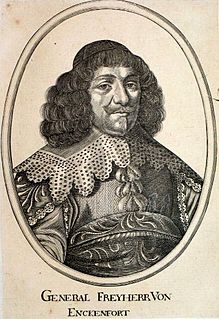 W
WAdrian von Enkevort was a Brabantine nobleman and Generalfeldmarschall who fought during the course of the Thirty Years' War and the Franco-Spanish War (1635–59). Born in 1603, Enkevort followed his father's footsteps becoming an officer, his first success came in 1632 when he distinguished himself at the Battle of Lützen, receiving the rank of Oberstleutnant in the forces of the Holy Roman Empire. He was later sent to the Lorraine front where he assisted Charles of Lorraine in reclaiming his lost realm. After a short spell in the Spanish invasion of Picardy, he returned to Lorraine where he was captured by the French, spending three years in captivity. Upon his return in 1641, he was promoted to Generalfeldmarschall and dispatched to Germany where he campaigned extensively. In 1647, he became the supreme commander of the Bavarian forces, serving in this capacity until the end of the war. He was subsequently ennobled and received the sum of 3,000 Goldguldens for his service during the war. He died in 1663.
 W
WPrince Eugene Francis of Savoy–Carignano better known as Prince Eugene was a field marshal in the army of the Holy Roman Empire and of the Austrian Habsburg dynasty during the 17th and 18th centuries. He was one of the most successful military commanders of his time, and rose to the highest offices of state at the Imperial court in Vienna.
 W
WFerdinand III was from 1621 Archduke of Austria, King of Hungary from 1625, King of Croatia and Bohemia from 1627 and Holy Roman Emperor from 1637 until his death in 1657.
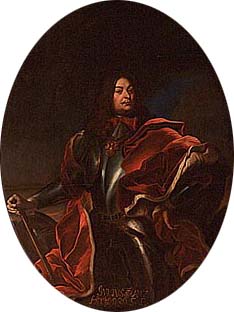 W
WJulius Francis was duke of Saxe-Lauenburg between 1666 and 1689. He was a son of Duke Julius Henry and his third wife Anna Magdalena of Lobkowicz, daughter of Baron William the Younger Popel of Lobkowicz. He was officially known as Julius Franz von Sachsen, Engern und Westfalen.
 W
WFrederick VI, Margrave of Baden-Durlach was the Margrave of Baden-Durlach from 1659 until his death.
 W
WFrederick Charles of Württemberg-Winnental was since 1677 Duke of the new-founded line of Württemberg-Winnental and regent of the infant Duke Eberhard Ludwig.
 W
WMatthias Gallas, Graf von Campo und Herzog von Lucera was an Austrian soldier, who first saw service in Flanders, then in Savoy with the Spaniards, and subsequently joined the forces of the Catholic League as captain during the Thirty Years' War.
 W
WAnnibale Gonzaga was commander of the city of Vienna, imperial field marshal and president of the Hofkriegsrat.
 W
WGottfried, Count Huyn, Baron of Gleen or Godefridus Comes ab Huyn Baro de Geleen, rose to the rank of Field Marshal in the service of the Holy Roman Emperor during the 30 Years War.
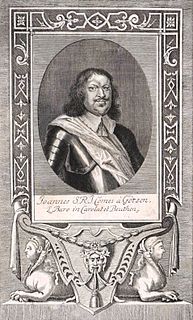 W
WJohann von Götzen was a Lüneburg nobleman and Generalfeldmarschall who fought during the course of the Thirty Years' War. He was married to Elisabeth v. Fal(c)ken (?-1631) Falke, Falcken, Falken, Falkenreck. They had two sons: Johann Sigismund Count of Götzen (1622-1622) and Johann Georg Count of Götzen (1623-1679). At the outbreak of the war Götzen joined the army of the Electoral Palatinate, defecting in to the Imperial side after the battle of Dessau Bridge. He attained the rank of Generalfeldmarschall in both the Electorate of Bavaria and Holy Roman Empire, gaining a reputation for his bravery. He was killed on 5 March 1645, while commanding the Imperial cavalry during the Battle of Jankau.
 W
WMelchior Graf von Gleichen und Hatzfeldt was an Imperial Field Marshal, who fought in the Thirty Years' War under Albrecht von Wallenstein and Matthias Gallas.
 W
WCount Heinrich von Schlick zu Bassano und Weißkirchen was an Imperial Field Marshal and president of the Hofkriegsrat.
 W
WHeinrich Holk was a Danish-German mercenary in both Christian IV of Denmark's and Albrecht von Wallenstein's service during the Thirty Years' War.
 W
WChristian von Ilow was a Neumark nobleman and Generalfeldmarschall who fought during the course of the Thirty Years' War. At the outbreak of the war, Ilow enlisted into the Imperial army, rapidly advancing through the lower ranks. Through his close association with Imperial Generalissimo Albrecht von Wallenstein, he attained the rank of Generalfeldmarschall. He was killed on 25 February 1634, in the Eger Bloodbath, the culmination of an internal purge of Wallenstein's supporters.
 W
WArchduke Leopold Wilhelm of Austria, younger brother of Emperor Ferdinand III, was an Austrian soldier, administrator and patron of the arts.
 W
WCount Walter Leslie was a Scottish soldier and diplomat. He gained the positions of Imperial Field Marshal, Count of the Holy Roman Empire, Governor on the Croatian-Slavonian Military Frontier, Imperial Ambassador to Naples, Rome in 1645 and to Constantinople in 1665–1666.
 W
WField Marshal Hermann Otto II of Limburg Stirum, count of Limburg Stirum and Bronckhorst, sovereign lord zu Gemen, was the son of Adolf Ernst of Limburg Stirum and an imperial Field Marshal.
 W
WVáclav Eusebius František, Prince of Lobkowicz was a Bohemian military leader and diplomat of the Lobkowicz family. After 1646, he was Duke of Sagan.
 W
WLouis William, Margrave of Baden-Baden was the ruling Margrave of Baden-Baden in Germany and chief commander of the Imperial army. He was also known as Türkenlouis for his many defeats of Turkish armies. After his death in 1707, his wife, Sibylle of Saxe-Lauenburg, acted as regent of Baden-Baden during the minority of his eldest son, who succeeded him as Margrave of Baden-Baden.
 W
WPhilipp von Mansfeld, was Graf von Mansfeld, Vorderort and Bornstedt who commanded troops during the Thirty Years' War. He first fought on the side of the Swedish Empire under his second-cousin, was captured, changed allegiance and raised a navy for General Albrecht von Wallenstein. Later, he commanded troops as Feldmarschall of the Holy Roman Empire.
 W
WDon Baltasar de Marradas et Vique or Maradas was a Spanish nobleman, imperial field marshal during the Thirty Years War and governor of Bohemia.
 W
WMattias de' Medici was the third son of Grand Duke Cosimo II de' Medici of Tuscany and Archduchess Maria Maddalena of Austria. He was governor of Siena, with interruptions, from 1629. He never married.
 W
WRaimondo Montecuccoli was an Italian-born professional soldier who served the Habsburg Monarchy. He was also a Prince of the Holy Roman Empire and Duke of Melfi, in the Kingdom of Naples.
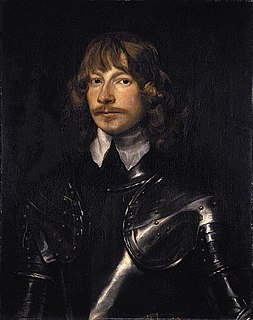 W
WJames Graham, 1st Marquess of Montrose was a Scottish nobleman, poet and soldier, lord lieutenant and later viceroy and captain general of Scotland. Montrose initially joined the Covenanters in the Wars of the Three Kingdoms, but subsequently supported King Charles I as the English Civil War developed. From 1644 to 1646, and again in 1650, he fought in the civil war in Scotland on behalf of the King. He is referred to as the Great Montrose.
 W
WGottfried Heinrich Graf zu Pappenheim was a field marshal of the Holy Roman Empire in the Thirty Years' War.
 W
WOttavio Piccolomini was an Italian nobleman whose military career included service as a Spanish general and then as a field marshal of the Holy Roman Empire.
 W
WCount Jean-Louis Raduit de Souches was a Field Marshal of the Habsburg Imperial Army of French descent.
 W
WOtto Christoph Freiherr von Sparr was a Generalfeldmarschall of Brandenburg-Prussia.
 W
WJohann von Sporck was a German nobleman and Generalfeldmarschall. Sporck was born in 1595 and he began his military career at the start of the Thirty Years' War as a private. His personal bravery and mastery of cavalry tactics led to his steady advancement through the ranks as well as his ennoblement. He later fought in the Second Northern War, the Austro-Turkish War (1663–64) and the Franco-Dutch War. He retired in 1676, having received the rank of Generalfeldmarschall and accumulating great riches. He died three years later. His son Franz Anton von Sporck became a publisher and a patron of arts.
 W
WPhilip Florinus of Pfalz-Sulzbach was an imperial field marshal.
 W
WRudolf von Tiefenbach was a German military commander who served the Holy Roman Empire during the Thirty Years' War.
 W
WJohann Tserclaes, Count of Tilly was a field marshal who commanded the Catholic League's forces in the Thirty Years' War. From 1620–31, he had an unmatched and demoralizing string of important victories against the Protestants, including White Mountain, Wimpfen, Höchst, Stadtlohn and the Conquest of the Palatinate. He destroyed a Danish army at Lutter and sacked the Protestant city of Magdeburg, which caused the death of some 20,000 of the city's inhabitants, both defenders and non-combatants, out of a total population of 25,000.
 W
WAlbrecht Wenzel Eusebius von Wallenstein, also von Waldstein, was a Bohemian military leader and statesman who fought on the Catholic side during the Thirty Years' War (1618–1648). His successful martial career made him one of the richest and most influential men in the Holy Roman Empire by the time of his death. Wallenstein became the supreme commander of the armies of the Habsburg Emperor Ferdinand II and was a major figure of the Thirty Years' War.
 W
WWalrad Usingen of Nassau, was from 1659 Count, and from 1688 Prince of Nassau-Usingen and founder of Usingen line of the House of Nassau.
 W
WCount Johann von Werth, also Jan von Werth or in French Jean de Werth, was a German general of cavalry in the Thirty Years' War.